Did you know that leaving a tree stump in your yard can attract pests like carpenter ants within just weeks? As surprising as it sounds, that lingering stump is more than an eyesore—it’s a magnet for unwanted critters and a threat to your landscape’s health. In this comprehensive guide, you’ll discover the fastest and most effective ways to conquer tree stump removal, keep your yard safe, and boost your curb appeal—saving you time, money, and enduring headaches.
A Surprising Fact About Tree Stump Removal
Contrary to popular belief, removing a tree stump doesn’t have to drag on for weeks or cost you a fortune. With the right approach tailored to your soil condition and the size of the stump, you can clear even the largest tree stumps in as little as a few hours. Many homeowners are astonished to learn that prompt stump removal not only prevents the spread of pests but also instantly improves landscape aesthetics and long-term soil health. Ignoring that pesky stump can lead to hidden issues—root systems can keep decaying underground, impacting new plantings and inviting ants and other pests. Read on to learn how smart, safe strategies can make tree stump removal much simpler than you thought.
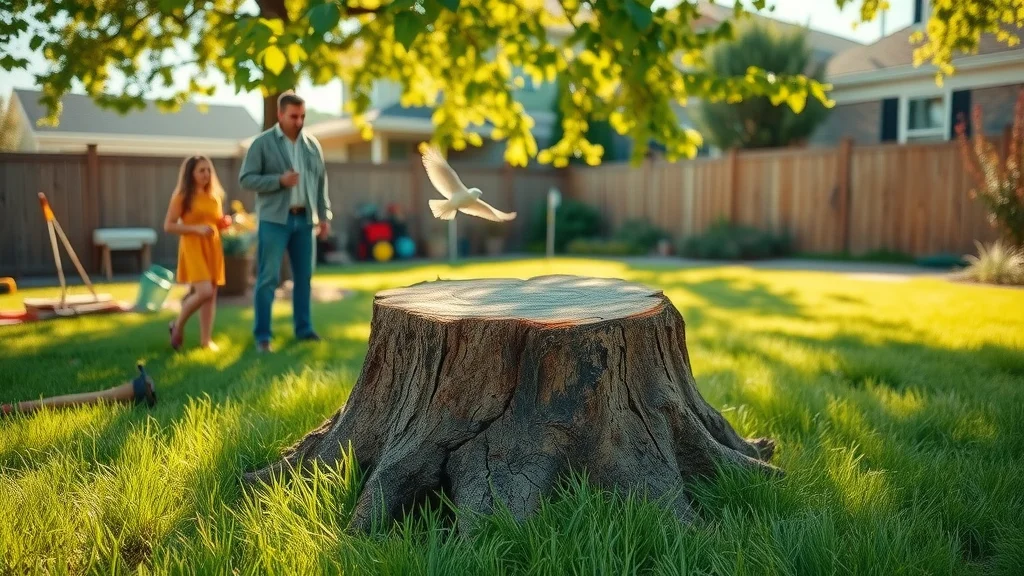
Why Fast Tree Stump Removal Matters for Homeowners
Prompt tree stump removal goes beyond tidy landscaping—it's about protecting your investment and prioritizing safety. Old tree stumps can trip up children, damage lawn equipment, or develop fungal growth that threatens nearby plants. Even the most harmless-looking stump hides a mass of roots capable of regrowing or impeding future landscaping projects. Unsightly stumps reduce property value, block lawn aeration, and complicate new plantings. Homeowners who delay stump removal risk additional costs if regrowth or hidden decay worsen over time. Fast and effective removal saves you time, preserves soil condition, and ensures your yard remains a safe environment for family, pets, and guests.
What You'll Learn About Tree Stump Removal
- Key tree stump removal options and how they compare
- Stump removal vs. stump grinding: pros, cons, and best use cases
- Essential safety and tree care tips
- Common mistakes in root system and soil condition management
- Professional vs. DIY solutions
Understanding Tree Stump Removal: The Basics
What Is Tree Stump Removal?
Tree stump removal refers to the process of extracting the entire stump and its root system from the ground after tree felling. Unlike simple cutting or tree trimming, stump removal involves addressing both the exposed stump and its network of roots, which can run several inches deep into the soil. Whether you’re dealing with freshly cut tree stumps or old, weathered remains, removing a tree stump completely prepares your landscape for replanting or construction. The methods used—manual, mechanical, chemical, or burning—vary in complexity and results, depending on the stump’s diameter, the root system’s density, and your desired timeline.
If you’re considering stump grinding as your removal method, it’s worth exploring a dedicated guide on how stump grinding can transform your yard and what to expect from the process. This resource breaks down the advantages, equipment, and best practices for achieving a flawless finish.
Why Remove a Tree Stump? Tree Care, Safety, and Curb Appeal
Leaving a tree stump untreated can cause multiple issues. Rotting stumps provide food and shelter for insects like carpenter ants and termites, becoming a nesting ground that threatens other trees and even your home. A lingering stump poses a tripping hazard, endangers lawn care equipment, and slows soil recovery after tree removal. From a tree care perspective, decaying stumps and their root systems disrupt nutrient cycling, while invading roots hinder new plant development. Visually, old tree stumps distract from landscaping updates, harming property value and reducing curb appeal. Prompt and thorough stump removal eliminates these risks, making your outdoor space safer, healthier, and more appealing.
Tree Stump Removal Techniques Explained
Manual Tree Stump Removal: Step-by-Step Guide
Manual tree stump removal is a popular option for smaller stumps or those with shallow root systems. This method typically involves using hand tools like shovels, axes, mattocks, and root saws. First, dig a trench around the stump, exposing as much of the root system as possible. Use the shovel to loosen and remove soil, then a mattock or ax to cut through side and tap roots. Persistent stumps may require extra leverage using steel rods or heavy-duty pry bars. While physical removal can be labor-intensive, it provides complete extraction of the entire stump and its roots—ideal for gardeners wanting to replant or reshape the landscape. Always wear personal protection equipment to prevent injury, especially if roots twist unpredictably or tools slip in damp soil.
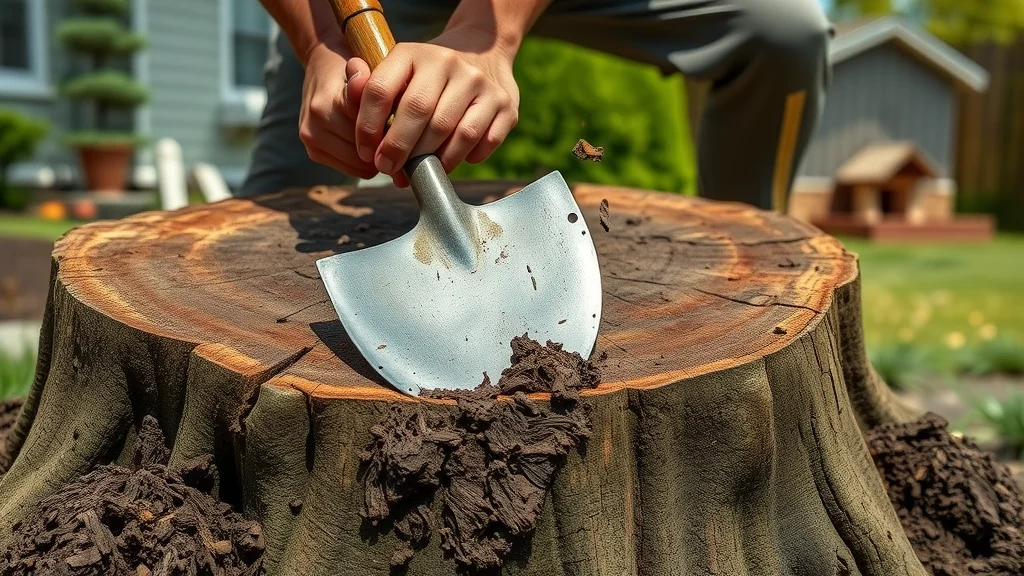
Stump Grinding: How It Works and When to Use It
Stump grinding is favored for its speed and efficiency, especially for medium-to-large stumps or in yards where multiple stumps need clearing. A stump grinder is a powerful machine that shreds the stump into wood chips by grinding it down below the soil line, often 6-12 inches deep depending on the diameter inch of the stump. This process rapidly eliminates visible stumps while leaving root systems to decompose naturally. Stump grinding is less labor-intensive than manual methods and creates mulch you can use for landscaping. However, it won’t remove the entire root ball, so regrowth is rare but possible. It’s ideal when quick surface clearance or landscaping is the goal, and it’s generally safer than burning. However, proper safety precautions and machine know-how are essential to avoid property or personal injury.
Chemical Methods for Tree Stump Removal
Chemical stump removal offers a low-effort, budget-friendly solution—but patience is key. Commonly, homeowners drill holes into the stump and fill them with a chemical stump remover or high-nitrogen fertilizer. Over several weeks, these products accelerate decomposition, allowing the stump and roots to rot and break down naturally. While this is one of the least physically demanding methods of tree stump removal, it is slower and requires careful handling of chemicals to prevent harm to children, pets, beneficial soil organisms, or nearby plants. Chemical removal is best for those in no rush and with difficult or hard-to-reach stumps where traditional tools or grinders can’t be safely used.
Burning a Tree Stump: Pros, Cons & Safety Advice
Burning is a traditional stump removal technique that involves setting the stump alight after prepping it with kindling and accelerants. This method reduces the stump to ashes over several hours, but it comes with notable safety and legal considerations. Open burning can pose fire hazards, especially in dry or windy conditions, and may be prohibited in urban areas or by local ordinances. Additionally, burning does not guarantee root system removal and could leave behind hidden underground dangers. Always check your area’s regulations and have safety precautions in place—like fire extinguishers and a water source—if you opt for this approach.
Get a comprehensive visual overview of tree stump removal methods—from digging and grinding to chemical and burning options. This step-by-step video demonstrates safety, equipment, root system prep, and before-and-after results so you can choose the method that fits your landscape needs.
Cost Analysis: Tree Stump Removal Options Compared
| Method | Average Cost | Time Required | Effectiveness | Safety |
|---|---|---|---|---|
| Manual Removal | $50–$150 (tools only) DIY labor |
1–4 hrs (small stump) Up to 1 day (large stump) |
Very High — removes entire stump & roots | Moderate — requires PPE and physical effort |
| Stump Grinding | $100–$400 (rental/hire) or $75–$350 (pro) |
1–2 hrs per stump (depending on diameter inch) |
High — grinds stump below soil line | High — safe if operated properly |
| Chemical Removal | $20–$60 (products) | 2–8 weeks (decomposition) | Moderate — roots may remain | Moderate — handle chemicals with care |
| Burning | $10–$50 (permits & fuel) | Half-day to 1 day | Variable — incomplete root removal | Low — fire hazard, legal limits apply |
Soil Condition and Root System Considerations
How Soil Condition Impacts Stump and Root Removal
The type and health of your yard’s soil play a crucial role in tree stump removal strategies. Dense clay soils and rocky substrates make manual or mechanical extraction harder, often requiring more time and force to dislodge the root ball and root systems. Meanwhile, loose or sandy soil can facilitate faster, easier removal of the entire stump and roots but may need extra stabilization after removal to prevent future settling. Fertile, loamy soil typically encourages deeper root growth, which means you might find roots extending several inches deep, complicating complete removal efforts. Assessing your soil condition before starting ensures you select the safest and most efficient method, avoid damaging underground utilities, and prepare adequately for soil rehabilitation post-removal.
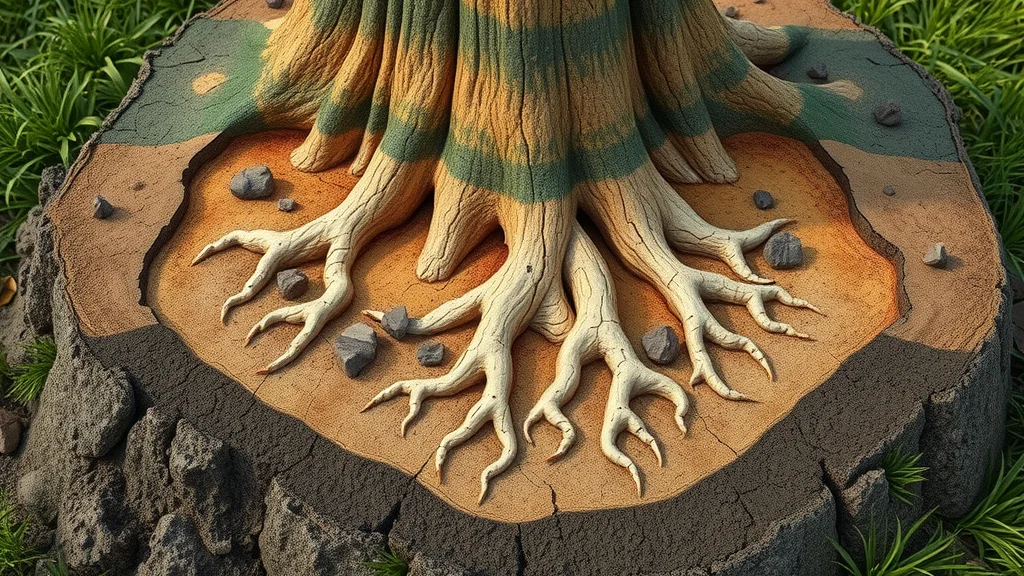
Managing the Root System for Complete Tree Stump Removal
For lasting success, focus on the entire stump and its root system—not just what’s visible above ground. Shallow-rooted tree stumps may lift out cleanly, but larger species can spread roots well beyond the diameter inch of the trunk, intertwining with other plants or structures. Incomplete removal leaves decaying roots underground, which can sprout suckers, attract pests, or destabilize the soil. Carefully trace and extract major roots during manual removal—use a root saw or ax to sever them cleanly. If using chemical or grinding methods, recognize that roots will typically remain but will degrade overtime and might need regrading or soil amendments. Pay attention to old tree removal sites—monitor for regrowth or soil subsidence in the months after removal for the best long-term landscape results.
DIY vs. Professional Tree Stump Removal: Which Is Right for You?
Tree Care and Safety Precautions for DIYers
Removing a tree stump on your own can be rewarding, but safety should never be compromised. Always wear full personal protection gear: helmet, goggles, gloves, boots, and sturdy workwear. Inspect all tools and machinery before use and keep bystanders clear of the work zone. If you’re grinding or burning a stump, follow all local codes and have fire safety measures ready. Be cautious of underground cables or pipes when digging—the risk of damaging infrastructure is real. Assess your physical ability for the task—stump removal can be strenuous, especially if the root system is extensive or soil condition is challenging. If you feel uncertain, consider consulting or hiring a professional tree service to avoid injury and ensure proper tree care.

When to Hire a Professional for Tree Stump Removal
Some situations demand a professional tree stump removal service. If your stump is large, situated close to structures, intertwined with utilities, or has a complex root system that manual tools can’t handle, hiring a professional tree service saves you time and prevents costly mistakes. Pros have access to commercial stump grinders, know how to manage different soil conditions, and can safely dispose of debris. They also obtain permits where burning or chemical treatments are legally regulated. The cost of stump removal by professionals may seem higher up front, but it guarantees clean, efficient results and peace of mind—especially important when property value, safety, and landscape health are on the line.
"Effective tree stump removal saves you time and future headaches. Always match the removal method to your specific soil condition and root system." — Certified Arborist
Essential Tools and Equipment for Removing a Tree Stump
- Manual tools (shovel, ax, mattock)
- Stump grinding machines
- Chemical stump removers
- Personal protection equipment
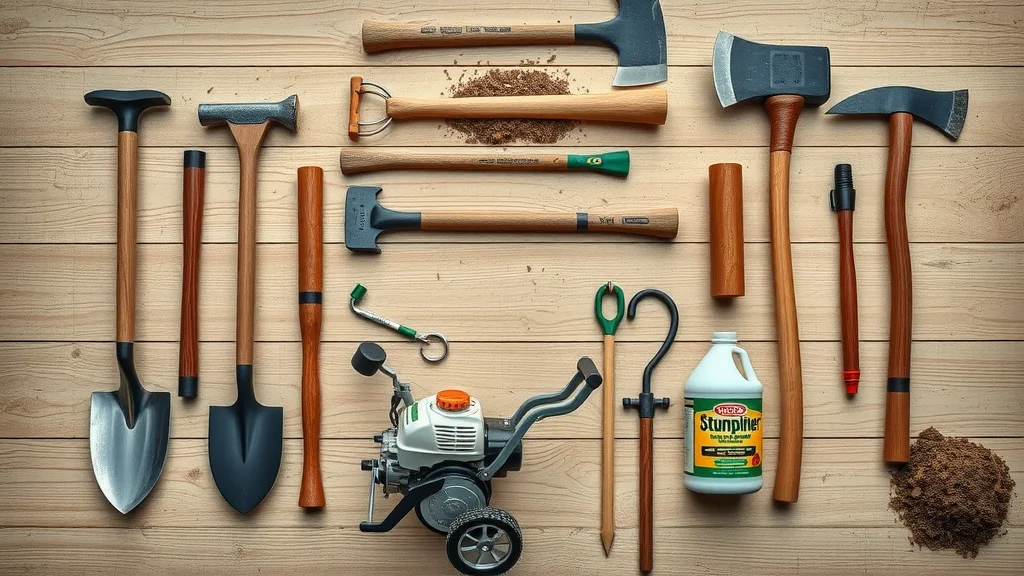
How to Remove a Tree Stump: Step-by-Step Instructions
- Assess soil condition and root system
- Choose your tree stump removal method
- Prepare the site and gear
- Follow the procedure for stump removal
- Address leftover roots and soil rehabilitation
Watch this demonstration of a professional-operated stump grinder. See each step—from prepping the worksite and ensuring safety, to efficiently grinding through tough stumps and cleaning up wood debris—so you know exactly what to expect whether you’re renting equipment or hiring a tree removal service.
Common Mistakes to Avoid in Tree Stump Removal
- Ignoring soil condition before removal
- Incomplete root system removal
- Unsafe stump grinding practices
- Improper stump disposal methods

People Also Ask: Tree Stump Removal FAQ
What is the easiest way to remove a tree stump?
Manual extraction and stump grinding are considered the easiest methods for most homeowners, depending on stump size and soil condition. Using a stump grinder often delivers the fastest, cleanest result.
How much should it cost to have a tree stump removed?
Average tree stump removal costs range from $75 to $350 per stump, but complex root systems or poor soil condition may increase the price. Chemical or manual DIY removal is generally less expensive but more labor-intensive.
How to get rid of a stump in 2-3 days naturally?
Accelerate natural decomposition using Epsom salt or high-nitrogen fertilizers. While these methods begin breaking down the stump within days, full removal typically takes longer depending on stump size and soil condition.
What will rot a tree stump quickly?
Nitrogen-rich products, commercial stump removers, or repeated soaking combined with soil bacteria can rot a tree stump in weeks to a few months.
Key Takeaways for Fast and Effective Tree Stump Removal
- Select the right tree stump removal method based on your stump, root system, and soil condition
- Combine safety and efficiency for the best tree care results
- Consider cost, time, and long-term landscape health
FAQs on Tree Stump Removal, Stump Grinding, and Root System Management
Can I remove a tree stump myself, or should I call a professional?
You can personally tackle small or medium-sized tree stumps with manual tools or a rental stump grinder if you’re comfortable with DIY projects and basic safety practices. However, if the stump is large, close to utilities, or if you have any doubts about the root system or soil condition, calling a professional tree removal service is the safest, most reliable option.
What are the benefits of stump grinding compared to complete stump removal?
Stump grinding offers fast results and less disruption to your landscape compared to manual stump removal, which eliminates both stump and root ball completely. Grinding is ideal for quick clearing, while full removal is best when you plan to replant or build over the site and need no root regrowth risk.
How do I restore soil condition after stump removal?
After tree stump removal, fill the hole with topsoil and compost, then reseed or replant as needed. Amending the soil with fertilizer aids in recovering soil health, helping new plants establish roots and restoring overall landscape vitality.
Is burning a tree stump safe and legal?
Burning a tree stump is only safe and legal if permitted by your local jurisdiction and done with proper precautions, including having fire-suppression equipment and monitoring weather conditions. Always check regulations before burning, and consider safer alternatives when in doubt.
Ready to Master Tree Stump Removal? Grow your landscaping expertise—call 203-271-7991 or visit TreeGuardianNews.com to subscribe.
For the fastest, safest, and most effective tree stump removal, always match the method to your specific stump, root system, and soil condition. Stay informed, prioritize safety, and never hesitate to consult an expert when in doubt!
If you’re looking to take your tree care skills even further, consider learning the essentials of cutting tree stumps correctly and maintaining your equipment for long-term success. Our in-depth article on essential tips for cutting tree stumps and keeping your chain sharp offers practical advice that complements your stump removal knowledge. By mastering both removal and cutting techniques, you’ll ensure your landscape projects are efficient, safe, and visually impressive. Explore these expert strategies to elevate your yard maintenance and achieve professional-quality results every time.
 Add Row
Add Row  Add
Add 

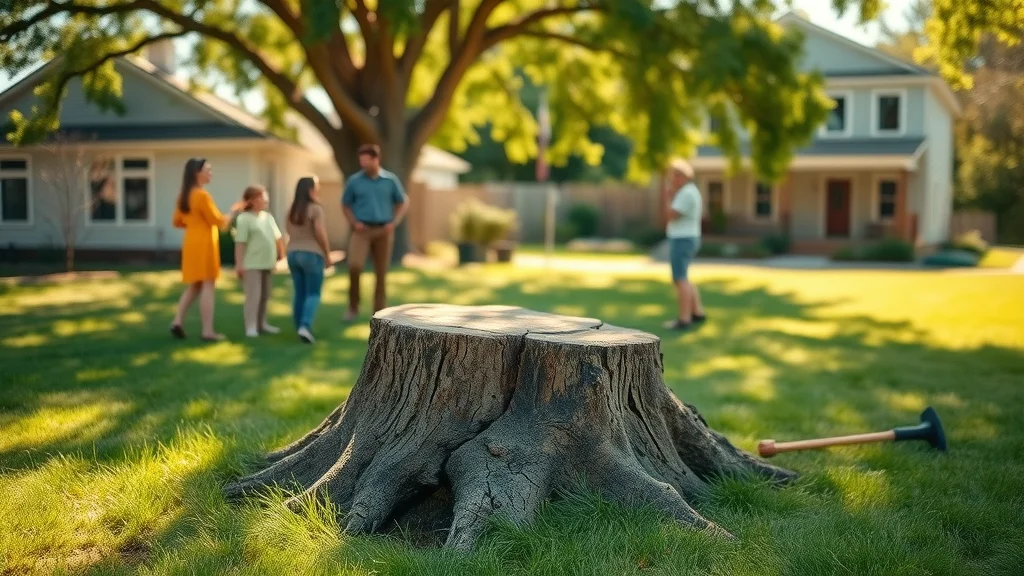
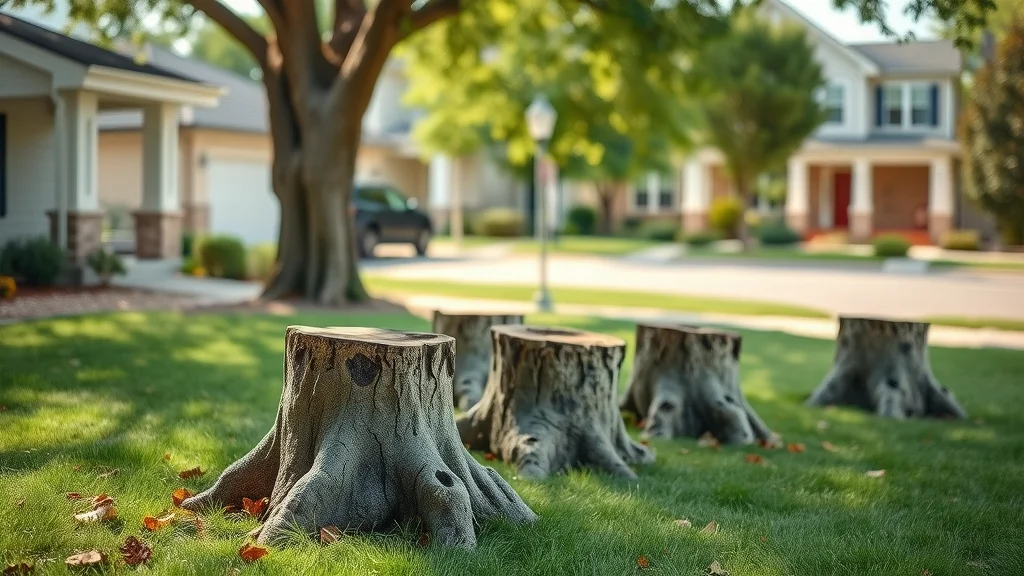

Write A Comment